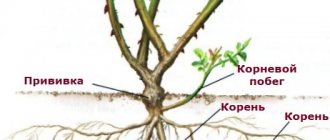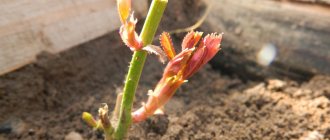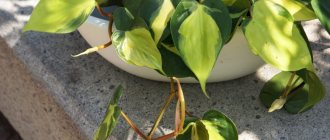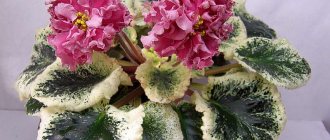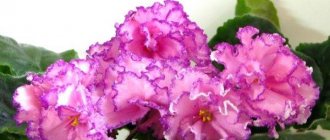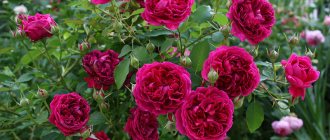Brief description of the Antik 89 variety
Antique 89 is classified as a looping rose; this variety is different:
- Large in size and classified as tall, the bushes reach 2-3 meters in height.
- They are wide, the stems are flexible but hard and require pruning.
- Flowers bloom in mid-summer, mainly at the end of the shoots.
- They are large in size and reach 13 centimeters in diameter.
- Rose has a pleasant, but not intrusive aroma.
- Suitable for cutting, retains its smell and appearance for 2 weeks.
The leaves of the plant are pleasant to the touch, green, bright, and not very many thorns. It does not require serious care and even beginners can cultivate flowers on the site.
Features in appearance
The variety is distinguished by a number of parameters that characterize it:
- in addition to a large, tall bush that blooms profusely, the plant is classified as repeat flowering, but the first flowering is longer than the second;
- roses form at the end of the shoots, the plant quickly forms young shoots;
- It is characterized by high winter hardiness, tolerates excess moisture well and is not afraid of bright sunlight;
- The flowers are bright, large, the petals curve outward, the petals are red in the central part and pink at the edges.
The bush looks spectacular, recovers quickly, blooms throughout the entire season, until October. They are not afraid of severe frosts, they do not burn under the sun, the light changes the shade of the petals, making them rich.
The plant has a pleasant aroma that persists even after cutting. Flowers can be used to decorate rooms; they are large and very beautiful.
Rose blossom
The plant is distinguished by abundant and lush flowering. This allows for the active use of culture in landscape design.
Period of activity and rest
Rose Monica (Monica) - what kind of cut variety is this, description
The culture is considered to be re-blooming. The first rich flowering is followed by a second. To do this you need to do the correct pruning. The second wave is characterized by no less lush buds. With the arrival of autumn cold weather, a period of rest begins.
Important! In order for flowering to continue as long as possible and to please with large buds, it is necessary to promptly remove dried flowers.
What to do if it doesn't bloom
The lack of flowering may be due to the following factors:
- incorrect choice of landing site;
- violation of the watering regime;
- deficiency of nutrients in the soil.
The main feature of the variety, bright detail Antique 89
A rose called Antique 89 with large, fragrant flowers attracts visitors with its impressive bud size. They bloom into beautiful, pink-red flowers.
Up to 5 inflorescences are tied on one thick stem. A characteristic feature of the variety is the uneven shade of the petals. Visually, the rose looks red, but the edges of the petals are pink.
During the first growing season, it may seem that the buds do not reach the desired size, the plant does not bloom profusely, and the shade of the petals is not the same. But the second growing season will change the gardener’s impression of the plant, so don’t rush to conclusions.
Diseases, pests and ways to combat them
Spider mites, aphids, leaf rollers, thrips, rose sawfly - a list of the most active parasites in relation to the Antique 89 rose. You can get rid of them using insecticides or folk remedies (for example, a soap solution or tobacco infusion).
Among the diseases, gray rot and powdery mildew can be considered the most dangerous. Irrigation of the plant with a solution of iron sulfate (3%), copper sulfate (2%) or Bordeaux mixture (3%) helps to cope with them.
Of course, growing an Antique rose will require a certain amount of time and effort. But following the above recommendations will greatly simplify the matter and allow you to admire the abundant flowering of this variety with fabulous colors.
Photo
anna_tikhvinskaya
anna_tikhvinskaya
nadbogdanova83
nadu__sha__
kattin.sad
Diseases
Are there dark spots on the shoots of the rose? This could be necrosis, find out how to save the plant
Bark necrosis on roses
Does the rose begin to wither and die for no apparent reason? It could be root rot, find out control and prevention measures
Root rot of roses
Girdle spots of brick and burgundy shades appear on the shoots of roses, find out why this happens
Infectious rose burn
Are there growths and cracks on the rose? It could be cancer, read what to do next
Common rose cancer
This is a product of a famous German company. At exhibitions, flowers were presented under various names.
The shape of the plant, its unusualness, brings back memories of times that came before.
Tips for growing and caring
It is recommended to trim the plant regularly, and trim to 3 buds. In this case, the flowers will be distributed evenly along the stems. And not at the bottom.
Other useful tips:
- During the growing season, it is worth keeping an eye on the dried out buds; they are removed and cut off.
- By winter, cover the root system of the bush with film material, in several layers, so that the rose does not freeze.
- Do not rush to remove the film in the spring, do it gradually, because the rose bush needs to get used to the light of the sun.
- Before planting, feed with compost; you can use humus for this purpose.
The plant has thick and elastic stems, it is difficult to hide them under a frame-type shelter; in cold winter they can freeze. In this case, dead shoots should be trimmed.
Plant care
Rose mix - what kind of houseplant is this?
For normal growth, the crop requires high-quality care. It should include timely watering, pruning, and fertilizing.
Watering rules and humidity
Climbing roses are easy to care for. Young crops need to be watered quite often. From the second year, the number of procedures can be reduced. In this case, watering must be made more abundant.
Fertilizing and soil quality
Plants should be fertilized 4-5 times during the growing season. In this case, it is worth using organic and mineral products. It is usually recommended to alternate such substances.
Pruning and replanting
Climber needs systematic pruning. The main lashes need to be shortened by a third, and the side ones should be trimmed to the third bud. Old and dry branches should be cut off close to the ground. This pruning helps the plant to rapidly grow shoots.
Features of wintering a flower
When growing a rose in a cold climate, it must be covered for the winter. To do this, in the spring the lashes are laid on a base of straw and covered in 2 layers of non-woven material. In spring, the cover should be gradually removed.
Useful tips for growing Antique 89
When cultivating a plant, various problems may arise; the following useful recommendations will help you avoid them:
- when planting a bush in the ground, add sand to the soil;
- during the growing season, use potassium and superphosphate fertilizers;
- The rose loves moisture, but the area will still have to be equipped with a drainage system.
If there is heavy rainfall, rose bushes may begin to rot, but this rarely happens. More often, dark spots appear on the leaves, which indicates excessive watering.
Growing a flower
The most suitable areas for climbers are areas that are open on the south, southeast or southwest side, where daylight lasts for at least 6 hours.
Rose Nina Weibull - what kind of floribunda is this?
The soil should be fertile, loose, optimally loam with a slightly acidic reaction. Antique should not be replanted too often so as not to expose the roots to injury. Planting in the ground is carried out in the spring, in April, or in the fall, when there are several weeks left before frost.
The process is:
- The soil is dug up in the selected location. If the soil at the planting site is unsuitable, then it is better to completely replace it, making the hole 2 times deeper.
- Prepare a hole 0.5 meters deep.
- When planting in clay soil, form a drainage layer of 15-20 cm; when planting in sandy soil, add up to 10 cm of clay soil.
- The seedling is inspected, the roots are shortened, completely removing non-viable ones.
- The roots are straightened inside the hole and covered with earth.
- The plant is watered abundantly and the settled soil is added.
- The area around the bush is mulched.
Important! Climbers should be planted at a distance of half a meter from the intended support so that the roots have enough space to grow.
Pests
Mole crickets have appeared in the garden, this is very dangerous for your flowers, find out how to get rid of the pest
Medvedka
Several sources of foamy liquid have been observed on the rose bush; this is a dangerous pest.
Slobbering Penny
Under the bright rays of the sun, the shoots may burn and dry out; if this happens, cut them off. The plant recovers quickly.
Advantages and disadvantages
Among the advantages:
- large size flowers, diameter 12-15 centimeters;
- the ability to use cut flowers for decoration;
- fast growth, pleasant aroma, disease resistance;
- the rose easily tolerates both heat and prolonged downpours;
- does not require special care, suitable even for beginners.
Let's talk about the disadvantages of roses:
- Requires shelter, despite its high resistance to frost and cold.
- You will have to prune to form a bush and regulate the flowering process.
- The soil will have to be mulched to reduce the frequency of watering.
- The bush is large in size, which does not suit all gardeners.
Agricultural technology
Before planting, immediately determine where the bush will grow, because frequent replanting will not benefit the plant. It is desirable that the area is well lit, protected from drafts, but has little ventilation. Planting can be done in spring (April) or autumn (late October-early November). Fertile, loose soil, such as loam, is suitable for Antique. Before planting, the area is dug up and nutrients are added - organic matter and mineral fertilizers, because the rose will bloom in one place for many years. For the winter in warm regions, the bush is not covered, but in cold regions it is advisable to lay it on a substrate of straw and cover it with a double layer of non-woven material on top. In spring, there is no need to rush to remove the cover immediately. Do this gradually, accustoming the plants to sunlight.
Pruning is very important for a climber. The main shoots are cut by 1/3, the side shoots are shortened to the 3rd bud. Old and dry branches are cut off close to the ground. Thanks to this pruning, the plant quickly grows young shoots. In order for the re-appearing buds to bloom as brightly as the first ones, do not forget that the faded heads must be trimmed in time. Fertilizing is carried out in the spring and after the first flowering.
An interesting feature of Antique is the ability to grow it not only as a climbing species. Thanks to its tough shoots, many rose growers grow the plant as a scrub. But according to reviews, the variety is not very suitable for arched structures, again due to poorly bending and thick shoots.
The Antique variety captivates with its unusual colors and long flowering. Rose growers praise its winter hardiness, ability to withstand bad weather and excellent immunity. The rose is unpretentious in care, so it is suitable for beginner gardeners. Of the minuses, many note that abundant flowering mainly appears only at the ends of the shoots. And due to the rigidity of the branches, difficulties arise with shelter in winter.
Back and forth


